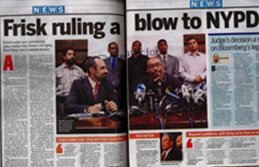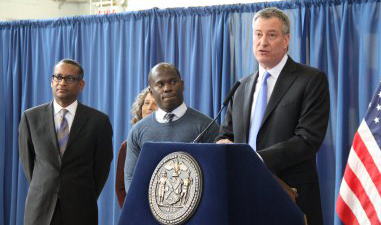Overview:
In August 2013, a federal judge found that the New York Police Department (NYPD) had engaged in a widespread practice of unconstitutional and racially discriminatory stops and frisks and ordered a collaborative, joint remedial process (JRP) to develop a set of reforms to help bring the NYPD’s stop-and-frisk practices into compliance with the Constitution. The JRP was envisioned to solicit ideas for additional reforms from communities most impacted by stops and frisks. In addition to community stakeholders, the process included the City, members of law enforcement, local elected officials, organizations with expertise in policing, and criminal justice attorneys representing the plaintiffs. This process echoes a similar process successfully implemented in Cincinnati, Ohio over a decade ago to address systemic abusive and biased policing practices. The JRP was led by the court-appointed facilitator, Hon. Ariel Belen. The JRP was designed to ensure that communities who were directly affected by these practices had direct input into shaping the future of stop and frisk in New York. Judge Belen issued his final report and recommendations in May 2018.
What Is the Joint Remedial Process?
In August 2013, after a nine-week trial, the court found that the NYPD’s practice of stop and frisk was unconstitutional and racially discriminatory and ordered the NYPD to engage in this Joint Remedial Process. In its ruling, the court specifically wrote that meaningful and lasting reform requires the support and involvement of the people most affected. As the court emphasized:
The communities most affected by the NYPD’s use of stop and frisk have a distinct perspective that is highly relevant to the crafting of reforms. No amount of legal or policing expertise can replace a community’s understanding of the likely practical consequences of reforms in terms of both liberty and safety....
If the reforms to stop and frisk are not perceived as legitimate by those most affected, the reforms are unlikely to be successful. Neither an independent Monitor, nor a municipal administration, nor this Court can speak for those who have been or will be most affected by the NYPD’s use of stop and frisk.
The purpose of the Joint Remedial Process, as stated by the court, was to develop a set of reforms with the direct input of the people most affected by the NYPD’s discriminatory stop-and-frisk practices. Those reforms were aimed to supplement the reforms to policies, trainings, supervision, discipline, and monitoring being developed by the plaintiffs, the NYPD, and the court-appointed monitor in the Floyd v. City of New York lawsuit.
What Did the JRP Final Report Recommend?
This landmark community input process, ordered by the court to address the NYPD’s constitutional violations, was conducted over a three-year process, confirming a significant number of experiences of affected New Yorkers. Judge Ariel Belen outlined 14 specific reform recommendations based on the community input, and a series of policy reforms that merited further consideration. After he issued the report, we asked the court to order the NYPD to implement his suggested changes.
Since the final report was issued, three of the JRP recommendations have been ordered by the court (including a pilot to activate body-worn cameras at lower level encounters; the documentation of level 1 and level 2 stops, and creating permanent structures for officer feedback), and another 11 remain to be considered. These oustanding recommendations include but are not limited to: publishing a monthly NYPD discipline report; the development of a discipline matrix; improving access to stop reports for the public; developing a community body to help implement reforms and assess compliance with the reforms; developing SQF (Stop Question Frisk) training related to interactions with people with disabilities; implementing more training around LGBTQI communities and adherence to the 2012 Patrol Guide revisions; and issuing civil summonses for trespass offenses, among others. The Floyd facilitator also made a number of related policy recommendations.
Throughout the JRP, the Center for Constitutional Rights, as lead counsel for the Floyd plaintiffs, worked diligently with the facilitator to ensure a meaningful and robust process.
How Did the Facilitator Design the Floyd Joint Remedial Process and Receive Community Input?
The JRP included a series of consultations, including:

(1) focus groups of those most affected by the NYPD’s unlawful stop-and-frisk practices;
(2) an advisory committee for Judge Belen and his staff, comprised of plaintiff representatives, community organizations, NYPD leadership, police union representatives, law enforcement officer of color organizations, religious leaders, and academics;
(3) conversations between Judge Belen’s team, community leaders, and police accountability experts on police reform issues; and
(4) structured community forums.
Key JRP Moments:
September 2015: Launch of JRP Advisory Committee
The committee was comprised of JRP stakeholders including Floyd plaintiffs; representatives from affected communities, including members of Communities United for Police Reform; NYPD leadership; and religious and academic leaders, and was convened to advise Judge Belen and his staff on how to structure the JRP.
October 2015 - February 2016: Convening of Focus Groups
Forty focus groups, each comprised of eight to ten members from communities across the city, were convened by Judge Belen and his staff in collaboration with several grassroots organizations around the city to elicit input on potential reforms. The Floyd focus groups were conducted through February 2016.
Participants were selected in collaboration with community organizations. We worked to ensure that the focus group participants represent a cross-section of those most affected by the NYPD’s practices, including young Black men, LGBTQI youth of color, homeless people, immigrants, public housing residents, and people recently released from prison. We reviewed and analyzed transcripts from each focus group as well as common themes for recommended reforms.
October - December 2016: Community Forums
Nearly 30 community forums were held throughout New York City in order to afford the public the opportunity to weigh in on proposed reforms and comment on themes and findings from the focus groups. Nine of these forums were organized by Communities United for Police Reform.
Fall 2016 - February 2017: Leadership Meetings
Judge Belen and his team held a series of informal “leadership” meetings with representatives from some of the JRP stakeholder groups as well as organizations with expertise in criminal justice and/or policing to solicit additional ideas for potential reforms.
May 2018: Facilitator Issues Final Report
The facilitator issued a final report with recommended reforms compiled from the input gathering process.
Learn more about how we got here:
- 1999: Killing of Amadou Diallo and Filing of Daniels lawsuit
After the killing of Amadou Diallo by the NYPD Street Crime Unit, the Center for Constitutional Rights and others file Daniels v. City of New York, challenging the constitutionality of the stop-and-frisk practices of the NYPD Street Crime Unit, with the National Congress for Puerto Rican Rights and MXGM members as plaintiffs. - 2003: Daniels Settlement
We settle with the NYPD, which agrees to disband the unit, adopt a written policy against racial profiling, and create a stop-and-frisk paperwork audit system. In the following years, the number of stop and frisks skyrockets, with the vast majority of stops in communities of color. - 2008: Floyd v. the City of NY
The Center for Constitutional Rights and co-counsel file Floyd v. the City of New York, a federal class action lawsuit against the City of New York that challenges the NYPD’s practices of racial profiling and unconstitutional stop and frisks. We receive and make public detailed data from the NYPD about its use of stops. - March - May 2013: Floyd Trial
Impacted community members pack the court for nine weeks of trial. Over 100 witnesses testify.

- August 12, 2013: LANDMARK VICTORY!
A federal judge finds the NYPD liable for a widespread practice of unconstitutional and racially discriminatory stop and frisks. She appoints an independent monitor to oversee a process for developing reforms that must include the input of communities most heavily impacted by stop and frisk.

- August - October 2013: City Appeals
The City appeals to the U.S. Court of Appeals for the Second Circuit and asks to halt the reform process. The police unions file motions to intervene in the case. In response, a broad base of New Yorkers file declarations about the importance of the reform process. - October - December 2013: Appeals Court Temporarily Halts Reform Process
A three-judge panel for the Second Circuit Court of Appeals halts the reform process and removes the district court judge from the case but does not overturn the August rulings on liability and remedy. There is public outcry over the judge’s removal. The Center for Constitutional RIghts and others, including the judge, file motions for reconsideration before the entire appeals court.
Mayor-elect Bill de Blasio promises to drop the appeals once he enters office. The court puts on hold the police unions’ motions to intervene in order to give de Blasio and the Floyd plaintiffs the chance to try to resolve the case in early 2014. The outgoing mayoral administration files a merits brief for the appeal.

- January 2014 - September 2015: Agreement Announced
In January 2014, Mayor de Blasio and the Floyd legal team announce agreement to drop the appeal and move forward with reforms.The district court denies the police unions’ motions to intervene and agrees to modify the August 2013 remedial order by defining the term of the court-ordered monitor. The City of New York formally withdraws its appeal.
- 2015 - present
- CCR meets with the monitor and facilitator to discuss immediate reforms and the collaborative Joint Reform Process (JRP).

